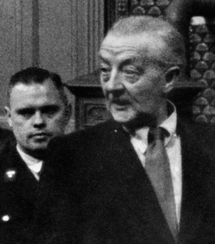Dutch museum honours forger who stung it for a fortune
Mariette le Roux
ROTTERDAM, Mariette le Roux- An art forger who sold a fake to Nazi air force chief Hermann Goering is finally getting the recognition that eluded him in life -- from a museum he famously conned out of a small fortune seven decades ago.
The Boijmans van Beuningen museum in the Dutch port city of Rotterdam has swallowed its wounded pride to host an exhibition focusing on the tricks and tools of Han van Meegeren, one of history's most successful art forgers.

Han van Meegeren during his forgery trial in 1947.
"It is ironic, I guess, but art is ambiguous," curator Friso Lammertse told AFP of the exhibition, which runs until August 12.
"Of course, forgery is wrong. But Van Meegeren was a master of his craft, that of forgery."
The fake Vermeer, "The Supper at Emmaus," drew huge crowds at the time -- "people stood in silent reverence before this painting," the curator said -- and enjoys pride of place in this exhibition.
Entitled "Van Meegeren's Fake Vermeers," the exhibition showcases some of the forgeries he sold before he died in 1947 aged 58, test canvasses found in his studio, and some of his ingenious forging methods.
There is a painting "Woman playing the lute" in the style of Vermeer, torn and damaged so as to appear old, a wine glass Van Meegeren duplicated in some paintings, and tubes of pigments found at his villa in Nice, France.
Also on display is a book of poetry he gave former Boijmans museum director Dirk Hannema, signed: "In admiration of his work."
Hannema had bought "The Supper at Emmaus" for the museum.
Painted by Van Meegeren around 1937, it was described by the renowned art publication The Burlington Magazine as "The masterpiece of Johannes Vermeer".
The canvas was widely accepted as a rare example of the Dutch Golden Age painter's earlier work.
"The art world found what it was looking for," Lammertse said. "That tends to diminish critical judgment."
Born in 1889, Van Meegeren never received the critical acclaim he sought as an artist in his own right, the museum says.
On trial for forgery in 1947, he said he had entered the dubious craft "to put the experts, who control the art trade, to the test".
"Like most people, he wanted ever-lasting fame," said Lammertse. "In a way, he did become world famous though nobody knew then that it was his work. That must have given him some degree of satisfaction."
Van Meegeren started out painting works in the style of Frans Hals, later switching to Vermeer after the success of "The Supper at Emmaus".
He painted his fakes on original 17th century canvasses. He scraped off the old paint, used natural pigments common at the time of Vermeer, cracked the dried surfaces, and smeared Indian ink into the cracks to make the works look authentic.
He also used Bakelite, a synthetic resin developed in the first half of the 20th century -- heating the finished product in an oven to harden the surface.
This allowed his canvasses to withstand the so-called "alcohol test" of the time, which would see a drop of alcohol wiped over the paint surface to check that it does not dissolve -- a sign of a modern painting or a fake.
At the height of a successful forging career, Van Meegeren was arrested in May 1945 on suspicion of collaboration after a "Vermeer" he had sold to Goering for 1.65 million guilders two years earlier, "Christ and the woman taken in adultery," was traced back to him.
To avoid going to jail for selling Dutch cultural heritage to the Nazis, he soon admitted he had painted that canvas and others, including "The Supper at Emmaus".
Many of the items now on display were exhibits at Van Meegeren's subsequent trial, at the end of which he was found guilty of forgery and sentenced to one year in jail.
He died of a heart attack shortly after the verdict.
-----------------------------------------------------------------------------